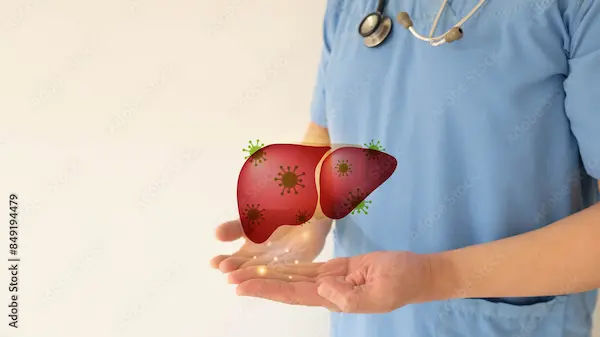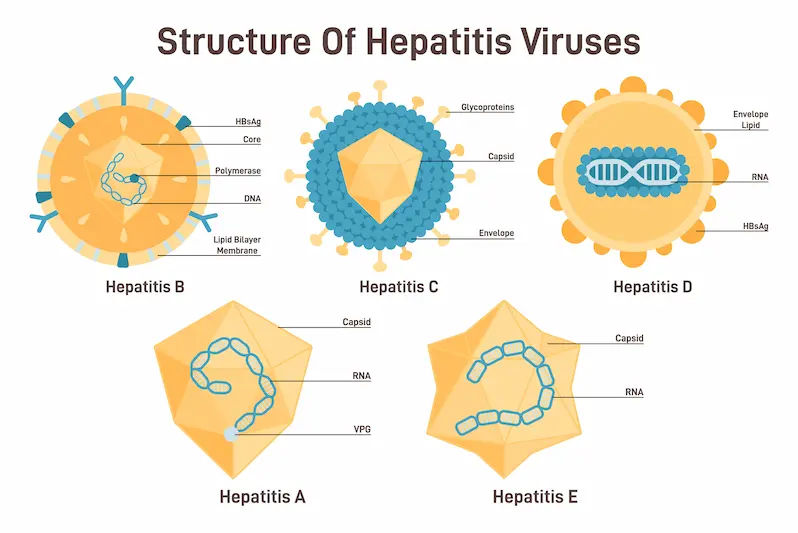What Leads To Signs Of Hepatitis Types
Learn the common and specific signs of hepatitis A, B, C, D, and E, including early warning symptoms, risks, and when to see a doctor.


Introduction
Hepatitis is a medical term that simply means inflammation of the liver. While often caused by a virus, this condition can stem from other factors like heavy alcohol use or an autoimmune disorder. The tricky part is that the signs of hepatitis can be vague, easily mistaken for the flu, or sometimes absent altogether until significant liver damage has occurred. Understanding the different types—A, B, C, D, and E—is crucial because their causes, symptoms, and long-term effects vary dramatically. This guide will walk you through the specific signs associated with each type of hepatitis, helping you recognise when it's time to seek medical advice. Whether you're concerned about a recent exposure or simply want to be informed, knowing what to look for is the first step towards protecting your liver health.
The Common Thread: General Signs of Liver Inflammation
Before diving into the specifics of each viral type, it's important to recognise the common symptoms that can appear when your liver is inflamed, regardless of the cause. The liver is a vital organ responsible for filtering toxins, aiding digestion, and storing energy. When it's under attack, it sends out distress signals. These general signs of hepatitis include:
- Fatigue: This isn't just ordinary tiredness. It's a profound and persistent exhaustion that doesn't improve with rest.
- Flu-like symptoms: Fever, muscle aches, and joint pain are common in the early stages of many viral infections,
including hepatitis. - Digestive issues: Nausea, vomiting, loss of appetite, and mild abdominal pain, especially on the right side under the rib
cage where the liver is located. - Jaundice: This is a classic sign of liver trouble. It involves the yellowing of the skin and the whites of the eyes, caused by
a build-up of a waste product called bilirubin that a healthy liver would normally process. - Dark urine and pale stools: As bilirubin levels rise, it can darken the urine to a brownish colour, while stools may
become clay-coloured.
If you experience a combination of these symptoms, especially jaundice, it's essential to consult a doctor. If these
symptoms persist beyond a week or are severe, consulting a doctor online with Apollo24|7 can provide initial guidance
and help you determine the next steps.
Hepatitis A (HAV): The Acute Short-Term Infection
Hepatitis A is typically an acute, short-term infection that does not become chronic. Most people recover completely
without permanent liver damage.
How Do You Get Hepatitis A?
The hepatitis A virus (HAV) is usually spread by the "faecal-oral route," meaning you ingest tiny amounts of
contaminated faeces. This can happen through:
- Consuming food handled by an infected person who didn't wash their hands properly.
- Drinking contaminated water or eating raw shellfish from polluted water.
- Close personal contact with an infected person.
Consult a Specialist for the best advice
Recognising the Signs of Hepatitis A
Symptoms of HAV often appear suddenly and can be mistaken for a severe stomach bug. They usually develop 2 to 6
weeks after exposure and can last for up to 2 months. Not everyone with HAV shows symptoms, especially children.
When present, signs include:
- Sudden onset of nausea and vomiting
- Abdominal discomfort
- Jaundice
- Low-grade fever
- Diarrhoea
The key insight with Hepatitis A is that it's an acute illness; it resolves on its own, and supportive care (rest, hydration,
good nutrition) is the primary treatment. Vaccination is highly effective for prevention.
Hepatitis B (HBV): From Acute Illness to Chronic Threat
Hepatitis B is a more serious concern. While some people fight it off in an acute phase, for others, the infection becomes
chronic, leading to long-term liver problems like cirrhosis (scarring) or liver cancer.
Modes of Hepatitis B Transmission
HBV is spread through contact with infectious blood, semen, or other body fluids. Common transmission routes
include:
- Unprotected sexual contact.
- Sharing needles or syringes.
- Accidental needle sticks (healthcare workers).
- From mother to baby during childbirth.
Acute vs. Chronic Hepatitis B Symptoms
The acute phase of HBV infection can produce symptoms similar to Hepatitis A—jaundice, fatigue, nausea—but they
can be more severe. The critical difference lies in the outcome.
The Danger of Silent Progression
Many adults with acute HBV recover completely. However, a significant portion, especially infants and young children,
develop a chronic Hepatitis B infection. The frightening aspect is that chronic HBV can be a "silent" disease for decades.
People may feel perfectly fine while the virus slowly damages the liver. When symptoms of chronic liver disease finally
appear, they can indicate advanced scarring (cirrhosis) and may include:
- Abdominal swelling (ascites)
- Easy bruising or bleeding
- Confusion or drowsiness (hepatic encephalopathy)
- Spider-like blood vessels on the skin (spider angiomas)
This silent progression is why screening for HBV is so important for at-risk individuals. A simple blood test can detect
the infection early. If you believe you've been exposed to HBV, a doctor can order a blood test. Apollo24|7 offers
convenient home collection for tests like liver function panels and hepatitis serology.
Hepatitis C (HCV): The "Silent Epidemic"
Hepatitis C has earned its nickname as the "silent epidemic" because most people infected with HCV are unaware of it.
For most, the initial infection causes no signs of hepatitis.
Primary Risk Factors for Hepatitis C
HCV is primarily spread through blood-to-blood contact. The most common route is:
- Sharing needles or other equipment used to inject drugs.
Other risks include unsterilised medical equipment (in settings with poor infection control), needlestick injuries, and, less
commonly, sexual contact.
Why Hepatitis C Symptoms Are Often Missed
Approximately 70-80% of people with acute Hepatitis C have no symptoms. If symptoms do occur, they are typically
mild and flu-like, making them easy to dismiss. The major threat of HCV is its high likelihood of becoming chronic—
about 75-85% of infected adults will develop a chronic infection. Like chronic HBV, it can progress silently for 20-30
years before causing significant liver damage and symptoms like those of advanced cirrhosis. The good news is that
modern antiviral medications can cure over 95% of people with Hepatitis C, making diagnosis through blood testing
critically important.
Hepatitis D (HDV): A Rare But Serious Co-Infection
Hepatitis D is an unusual and incomplete virus. It can only infect individuals who are already infected with Hepatitis B.
The Unique Link Between Hepatitis B and D
HDV uses the surface coat of the HBV virus to replicate. This means you can only get Hepatitis D if you have Hepatitis
B. It can occur as:
- Co-infection: Getting both HBV and HDV at the same time.
- Superinfection: Getting HDV after already having a chronic HBV infection.
A superinfection is usually more severe, often leading to a faster progression to serious liver disease. The symptoms are
similar to a severe case of Hepatitis B but tend to be more intense.
Hepatitis E (HEV): Similar to A, But With Key Differences
Hepatitis E is similar to Hepatitis A in that it typically causes an acute infection spread through contaminated water
(faecal-oral route). It is common in areas with poor sanitation.
Who is Most at Risk for Severe Hepatitis E?
While most people recover from HEV, it poses a serious threat to one specific group: pregnant women, particularly
those in their third trimester. HEV infection in this group can lead to acute liver failure and a high risk of mortality.
Symptoms are otherwise similar to HAV—jaundice, fatigue, nausea—and the infection usually resolves on its own.
Less Common Types: Autoimmune and Alcoholic Hepatitis
Beyond viruses, hepatitis can be caused by the body's own immune system attacking the liver (autoimmune hepatitis) or
by excessive alcohol consumption (alcoholic hepatitis). The signs of these types of hepatitis can mirror viral forms,
including fatigue and jaundice. Diagnosis often involves a combination of blood tests, imaging, and sometimes a liver
biopsy to identify the underlying cause.
When to See a Doctor: A Symptom Checklist
You should consult a healthcare professional if you experience any of the following, especially in combination:
- Jaundice (yellowing of skin or eyes).
- Abdominal pain that is persistent, particularly on the right side.
- Unexplained fatigue that interferes with your daily life.
- Dark urine or pale stools for more than a couple of days.
- Nausea and vomiting that leads to dehydration.
If you have any known risk factors (e.g., unprotected sex, shared needles, travel to areas with poor sanitation) and
develop flu-like symptoms.
Early diagnosis is key to managing hepatitis effectively and preventing long-term liver damage. If your condition is
causing concern, booking a physical visit to a doctor with Apollo24|7 ensures a comprehensive evaluation.
Consult a Specialist for the best advice
Consult a Specialist for the best advice

Dr. Rajib Ghose
General Physician/ Internal Medicine Specialist
25 Years • MBBS
East Midnapore
VIVEKANANDA SEBA SADAN, East Midnapore

Dr. Tanmaya Kumar Sahu
General Physician/ Internal Medicine Specialist
12 Years • MBBS, MD ( Internal Medicine )
Bhubaneswar
Apollo Hospitals Old Sainik School Road, Bhubaneswar

Dr. Sougata Kumar
General Practitioner
8 Years • MBBS
East Midnapore
VIVEKANANDA SEBA SADAN, East Midnapore

Dr. Abhirup Chakrabarti
General Practitioner
10 Years • MBBS
Chennai
Dr Abhirup Chakrabarti, Chennai

Dr. Tapabrata Ray
General Physician/ Internal Medicine Specialist
4 Years • MBBS,DGM,CPMeC,ACMDC
Kolkata
MCR SUPER SPECIALITY POLY CLINIC & PATHOLOGY, Kolkata
Consult a Specialist for the best advice

Dr. Rajib Ghose
General Physician/ Internal Medicine Specialist
25 Years • MBBS
East Midnapore
VIVEKANANDA SEBA SADAN, East Midnapore

Dr. Tanmaya Kumar Sahu
General Physician/ Internal Medicine Specialist
12 Years • MBBS, MD ( Internal Medicine )
Bhubaneswar
Apollo Hospitals Old Sainik School Road, Bhubaneswar

Dr. Sougata Kumar
General Practitioner
8 Years • MBBS
East Midnapore
VIVEKANANDA SEBA SADAN, East Midnapore

Dr. Abhirup Chakrabarti
General Practitioner
10 Years • MBBS
Chennai
Dr Abhirup Chakrabarti, Chennai

Dr. Tapabrata Ray
General Physician/ Internal Medicine Specialist
4 Years • MBBS,DGM,CPMeC,ACMDC
Kolkata
MCR SUPER SPECIALITY POLY CLINIC & PATHOLOGY, Kolkata
More articles from Hepatitis
Frequently Asked Questions
1. Can you have hepatitis and not know it?
Yes, absolutely. This is very common, especially with Hepatitis B and C. Many people have chronic infections for years without any noticeable signs of hepatitis until significant liver damage has occurred.
2. What is the first sign of hepatitis you might notice?
The most common early signs are non-specific and flu-like: profound fatigue, mild fever, and muscle aches. Jaundice, which is a more definitive sign, usually appears a bit later if it appears at all.
3. How long after exposure do hepatitis symptoms start?
This varies by type. Hepatitis A symptoms can appear in 2-6 weeks. For Hepatitis B and C, the incubation period is longer, typically ranging from 6 weeks to 6 months.
4. Is all hepatitis contagious?
No. Only viral hepatitis (A, B, C, D, E) is contagious. Hepatitis caused by alcohol (alcoholic hepatitis) or an autoimmune reaction (autoimmune hepatitis) is not contagious from person to person.
5. Can hepatitis go away on its own?
Acute viral hepatitis, like Hepatitis A and often Hepatitis B (in adults), can resolve on its own as the body clears the infection. However, chronic Hepatitis B and C generally do not go away without medical treatment.
.webp)



